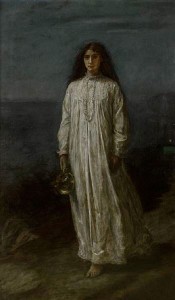Thus, the story here presented will be told by more than one pen, as the story of an offence against the laws is told in Court by more than one witness—with the same object, in both cases, to present the truth always in its most direct and most intelligible aspect; and to trace the course of one complete series of events, by making the persons who have been most closely connected with them, at each successive stage, relate their own experience, word for word. – The Woman in White
 The Woman in White by William Wilkie Collins (published in 1859) is narrated by several characters.
The Woman in White by William Wilkie Collins (published in 1859) is narrated by several characters.
Or should I say character witnesses?
Collins wrote the story after finishing law school and passing the bar. His education obviously influenced his writing style, a style that allows the reader to feel as if they’re reading eyewitness accounts and participating in an unfolding mystery.
Collins did not want to be a lawyer.
His father, however, did and was adamant for Wilkie to learn a trade or profession that would generate a steady income. Sometimes parents do know best!
So, it’s no wonder he tells this tale in a legalistic tone and detective-like voice. It’s ingrained in him.
And it’s so very unique, which makes it a fun read.
Besides being influenced by law school, Collins became close friends with Charles Dickens who encouraged him to write and was instrumental in building his career. Dickens published Collins’ short stories in his literary journals and also employed him as an actor in his theatre group, a group that performed works written by Dickens.
In The Woman in White, Walter Hartright, an art instructor, falls in love with the timid and beautiful Laura Fairlie who — for some unknown reason — resembles the strange and eerie woman in white that Walter meets along the road very early on in the story.
We later learn that this mysterious stranger in white is, in fact, Miss Ann Catherick, an escapee from an insane asylum.
This brief encounter (and the fact that Ann is crazy) lingers in the mind of the reader adding suspenseful tension and prompting questions.
Who is Ann?
Why was she institutionalized?
Is it just a coincidence that she looks so much like Laura Fairlie?
Collins leads you down that winding road of narrative misdirection as the puzzle pieces slowly — via different narrators — come together. Pieces such as: an arranged marriage, an inheritance, romance, insanity, murder, deception, bribery, and a very ridiculous uncle.
As much as I like Laura (Walter’s love interest), I must admit I find myself disappointed in his taste in women.
Marian Halcombe, Laura’s half sister, is clever, smart, funny, and a far better match for Walter.
But…she’s not pretty.
What can I say? That pissed me off.
The Woman in White could have been shorter, considerably. But you know these lawyer types.
They like to talk.
That being said, this is a page-turner! And I can see why the BBC and other literary groups still consider this book to be one of the best novels ever written.
